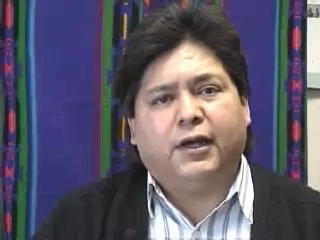We are Nimíipuu - Nez Perce Indians

Welcome from Sam Penney, Former Nez Perce Tribal Executive Committee Chairman
Please note: This project was originally published in 2002 as a module in Lifelong Learning Online - the Lewis & Clark Rediscovery Project.
In 2025 the content and media was migrated by University of Idaho Library to ensure continued access to this important and unique material. The original version can still be viewed at the archived site.
Please get in touch if you encounter issues or questions.
Scenario
In this module you will be introduced to the Nimíipuu, also called the Nez Perce. We have a rich and vibrant culture, which has existed since time immemorial and which continues to this day. As a result of your engagement in this module, you will gain a better understanding of the influence of the Nimíipuu not only on Lewis and Clark and the Corps of Discovery, but also on American history and culture. You will also gain an appreciation of how the Corps of Discovery impacted the Nimíipuu.
From our perspective, that of the Nimíipuu, you can glimpse our aboriginal culture before the arrival of the Corps of Discovery, and how it has continued to this day. You will then explore the significance of the arrival of Lewis and Clark among our people. How did we, the Nimíipuu, view the “discovery” of these strangers and the new world they brought with them? But as Lewis and Clark simply opened the door to a new and critical relationship with the American people, you can also explore what followed in the wake of Lewis and Clark. How did the missionaries, military generals, and treaty commissioners impact the Nimíipuu? Finally, you will conclude with an overview of the Nimíipuu today, considering some of the important initiatives and challenges we now face and how we are reasserting our sovereign rights.
Throughout this presentation, you can learn of the extensive knowledge the Nimíipuu have had and continue to use in successfully living in our environment, and in the management of our natural and cultural resources.
Geographical Location
Date: September 20, 1805
City: Weippe Prairie
Acknowledgements
This module was conceived and developed by the “Nimíipuu - Lewis and Clark Rediscovery Project Committee,” the members of which include Vera Sonneck (co-facilitator), Allen Pinkham, Josiah Pinkham, Ann McCormack, Nakia Williamson, Edith Powaukee, Sharon Stevens, Harold Crook and Rodney Frey (co-facilitator). Special thanks to Nakia Williamson for writing the biographies and to Edith “Wook” Powaukee for constructing the maps in this module. We also thank Dan Kane and Jason Goldammer of Lewis-Clark State College, Sally Thompson of the University of Montana, and Kenneth Furrow of Furrow Productions for additional video footage. Rodney Frey was responsible for editing video clips, writing initial drafts for many of the web pages, and for the construction of those pages, while Aaron Denham assisted with research and Heather Johnston transcribed the interviews and proof read the module’s texts. Thanks goes to Mary Lynn Walker for helping develop several of the educational activities that accompany this module. We also thank the Nez Perce National Historical Park and Robert Applegate for opening their archives to us.
But is was the elders and the other interviewees who we are most indebted to and owe our heartfelt thanks. It was their invaluable insights and knowledge that made this project possible. Their guidance and assistance brought “life” to this module.
Cultural Property
Before this module was released for public use, it was thoroughly reviewed for its accuracy and appropriateness by the Nimíipuu elders and by the Nez Perce Tribal Executive Committee. The Circle of Elders (on March 13, 2002), the Nez Perce Lewis and Clark Bicentennial Committee (on March 14), the Natural Resources Sub-Committee of NPTEC (on March 19), and NPTEC (on March 26) reviewed and approved this module for public educational use. In addition, transcripts of all interviews presented in this module were reviewed and approved by each interviewee. All information in this module, including interviews, maps, texts, and photographs, are the cultural property of the Nez Perce Tribe. See Cultural Property Rights Agreement.